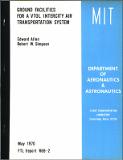Ground facilities for a VTOL intercity air transportation system
Author(s)
Allen Edward; Simpson, R. W.
DownloadFTL_R_1969_02.pdf (11.48Mb)
Alternative title
Ground facilities for a Vertical takeoff and landing intercity air transportation system
Other Contributors
Massachusetts Institute of Technology. Flight Transportation Laboratory
Metadata
Show full item recordAbstract
Introduction: This study covers the design of ground facilities, or metroports, for a future form of short haul intercity air transportation, the VTOL Airbus system as described by previous M.I.T. Flight Transportation Laboratory reports. This system will use VTOL aircraft, such as compound helicopters or tilt wings, which will operate from metroports sited throughout a metropolitan region, and will provide frequent service between the regions which make up an urban corridor, or megalopolis. The metroports are conceived as relatively compact installations placed in city center areas and at major roadway junctions throughout the surrounding suburban region. By providing shorter access and egress times for short haul passengers, and by avoiding airport taxi times and delays due to congestion, the Airbus service will offer substantially improved megalopolitan travel times at total costs comparable to those of the present air system. The service will be all weather, night and day, using its own airspace at the metroports, and a segregated airspace when the metroport is co-located with an airport. The trip lengths will vary between 30-300 miles, which would include travel generated by business commuters in the corridor region, and the travel arising from collecting and distributing the long haul air passenger to and from the major airports in the corridor. Previous systems engineering studies discovered that the ground facilities for such a VTOL system are easily the most important component. The usual predominance of the design and operation of the air vehicle did not hold for this new system, since the ground operations costs were projected to be much higher, and at least twice as much investment was expected to be required for new ground facilities as for new vehicles. Additionally, the time savings offered by the system were far more sensitive to the number and distribution of metroports than to vehicle speed.
Description
May 1969 Includes bibliographical references (p. 133-136)
Date issued
1970Publisher
Cambridge, Mass. : Flight Transportation Laboratory, Dept. of Aeronautics and Astronautics, Massachusetts Institute of Technology, [1970]
Other identifiers
13599737
Series/Report no.
FTL report (Massachusetts Institute of Technology. Flight Transportation Laboratory) ; R69-2
Keywords
Airports, Vertically rising aircraft, Design and construction